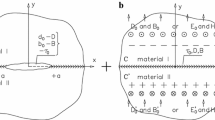We consider a plane strain problem for a piezoelectric/piezomagnetic bimaterial space with a crack in the region of the interface of the materials. At infinity, tensile and shear stresses and heat, electric, and magnetic flows are set. Using representations for all mechanical, thermal, and electromagnetic factors in terms of piecewise analytic functions, we formulate problems of linear conjugation that correspond to a model of an open crack and models taking into account the contact zone in the vicinity of a crack tip. Exact analytic solutions of the indicated problems are constructed. Expressions for stresses, the electric and magnetic inductions, jumps of derivatives of displacements, and electric and magnetic potentials on the interface are written. The coefficients of intensities of the indicated factors are presented. We derive a transcendental equation for the determination of the real length of the contact zone. The dependences of this length and the coefficients of intensity on the set external influences are investigated.
Similar content being viewed by others
References
F. D. Gakhov, Boundary-Value Problems [in Russian], Fizmatgiz, Moscow (1963).
A. R. Gachkevich and R. S. Musii, “Temperature field and the stressed state of a conductive layer under magnetic impact on the surface,” in: Physicomechanical Fields in Deformable Media [in Russian], Naukova Dumka, Kiev (1978), pp. 28–33.
H. S. Kit and R. M. Martynyak, “Thermoelasticity of a piecewise homogeneous body with a closed interface crack in the presence of contact thermoresistance between its edges,” Dopov. Nats. Akad. Nauk Ukr., No. 10, 84–88 (1996).
V. V. Loboda and T. V. Khodanen, “An interface crack in a piezoelectromagnetic bimaterial under the action of mechanical load, electric and magnetic fluxes,” Visn. Dnipropetr. Univ. Ser. Mekhanika., Issue 11, 2, 117–130 (2007).
N. I. Muskheshvili, Some Basic Problems of the Mathematical Theory of Elasticity, Springer, Berlin (1977).
E. L. Nakhmein and B. M. Nuller, “Contact of an elastic half-plane with a partially spalled stamp,” Prikl. Matem. Mekh., 50, No. 4, 663–673 (1986).
V. Z. Parton and B. A. Kudryavtsev, Electromagnetoelasticity of Piezoelectric and Electrically Conductive Bodies [in Russian], Nauka, Moscow (1988).
Ya. S. Pidstyhach, Ya. Yo. Burak, and V. F. Kondrat, “Magnetothermoelastic processes in conductive bodies under force loading,” Visn. Akad. Nauk URSR, No. 10, 12–21 (1979).
Ya. S. Podstigach, Ya. Yo. Burak, and V. F. Kondrat, Magnetothermoelasticity of Conductive Bodies [in Russian], Naukova Dumka, Kiev (1982).
I. V. Simonov, “Crack on an interface in a homogeneous stress field,” Mekh. Kompozit. Mater., No. 6, 969–976 (1985).
A. F. Ulitko and V. I. Ostrik, “Interface crack under conditions of frictional contact of the lips,” Visn. Kyiv. Univ., Ser. Fiz.-Mat. Nauky, Issue, 2, 133–141 (2002).
G. P. Cherepanov, “On the stressed state in an inhomogeneous plate with notches,” Izv. Akad. Nauk SSSR. Otd. Tekh. Nauk. Mekh. Mashinostroen., 1, 131–137 (1962).
M. Comninou, “The interface crack” J. Appl. Mech., 44, 631–636 (1977).
C.-F. Gao, H. Kessler, and H. Balke, “Crack problems in magnetoelectroelastic solids. Part I: Exact solution of a crack,” Int. J. Eng. Sci., 41, 969–981 (2003), “Crack problems in magnetoelectroelastic solids. Part II: General solution of collinear cracks,” Int. J. Eng. Sci., 41, 983–994 (2003).
C.-F. Gao and N. Noda, “Thermal-induced interfacial cracking of magnetoelectroelastic materials,” Int. J. Eng. Sci., 42, 1347–1360 (2004).
K. P. Herrmann and V. V. Loboda, “Contact zone models for an interface crack in a thermomechanically loaded anisotropic bimaterial,” J. Therm. Stresses, No. 24, 479–506 (2001).
K. P. Herrmann and V. V. Loboda, “Fracture mechanical assessment of electrically permeable interface cracks in piezoelectric bimaterials by consideration of various contact zone models,” Arch. Appl. Mech., 70, 127–143 (2000).
I. V. Kharun and V. V. Loboda, “A set of interface cracks with contact zones in combined tension-shear field,” Acta Mech., 166, 43–56 (2003).
G. C. Sih and Z. F. Song, “Magnetic and electric poling effects associated with crack growth in BaTiO3 – CoFe2O4 composite,” Theor. Appl. Fract. Mech., 39, 209–227 (2003).
B. L. Wang and J. C. Han, “Multiple cracking of magnetoelectroelastic materials in coupling thermo-electro-magneto-mechanical loading environments,” Comput. Mater. Sci., 39, 291–304 (2007).
M. L. Williams, “The stresses around a fault or cracks in dissimilar media,” Bull. Seismol. Sos. Am., 49, 199–204 (1959).
Author information
Authors and Affiliations
Additional information
Translated from Matematychni Metody ta Fizyko-Mekhanichni Polya, Vol. 51, No. 3, pp. 121–132, July–September, 2008.
Rights and permissions
About this article
Cite this article
Loboda, V.V., Khodanen, T.V. Problem of thermoelectromagnetoelasticity for a piezoelectric/piezomagnetic bimaterial with interface crack. J Math Sci 165, 301–317 (2010). https://doi.org/10.1007/s10958-010-9799-y
Received:
Published:
Issue Date:
DOI: https://doi.org/10.1007/s10958-010-9799-y




